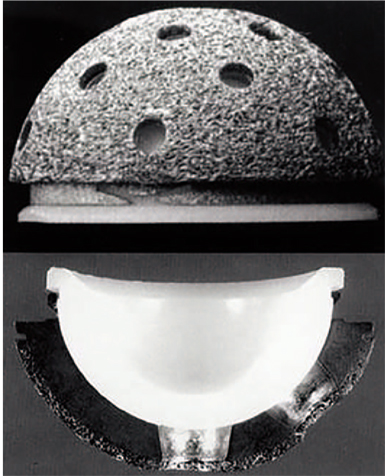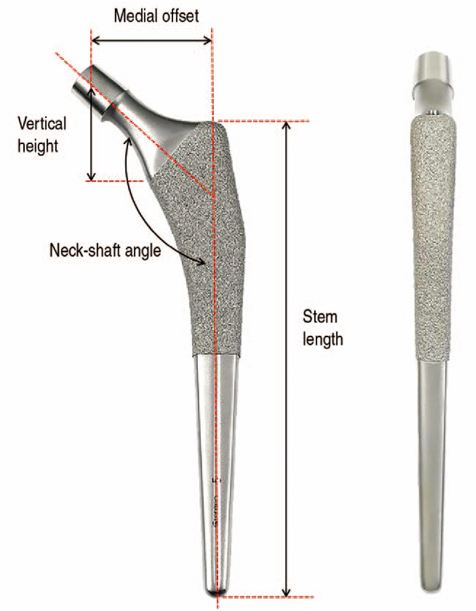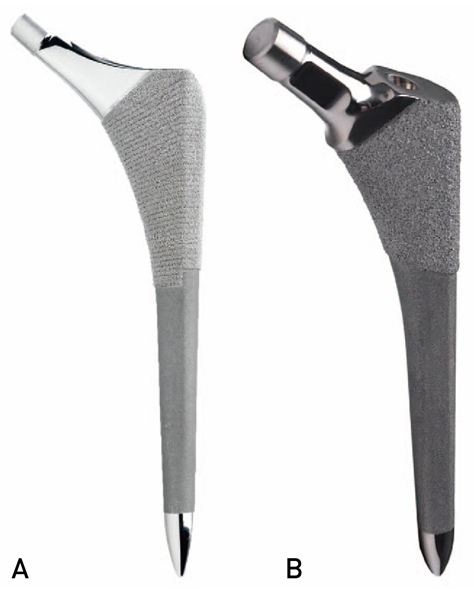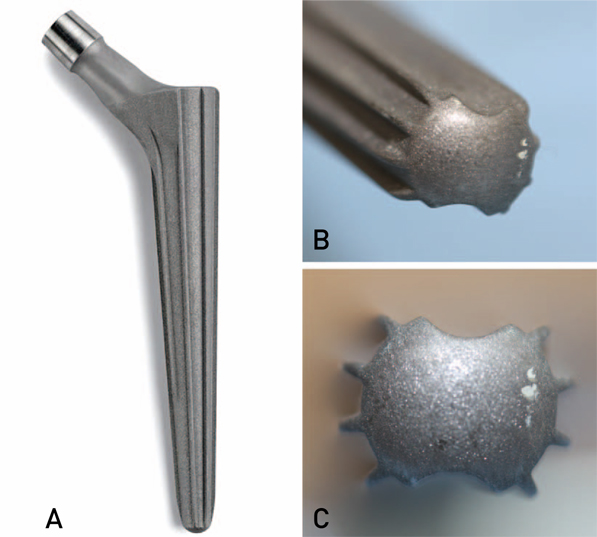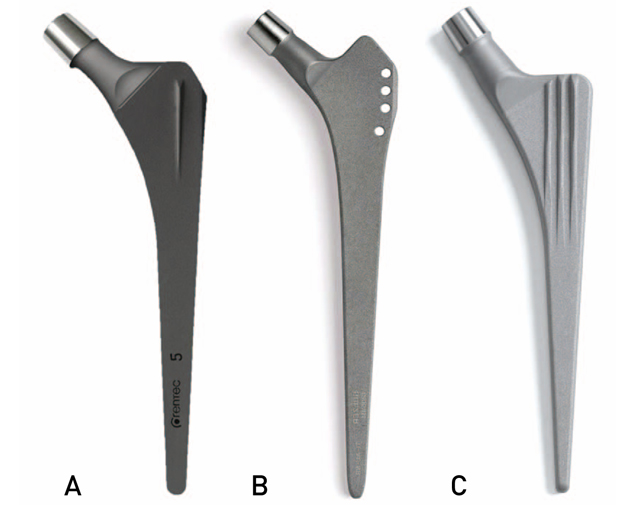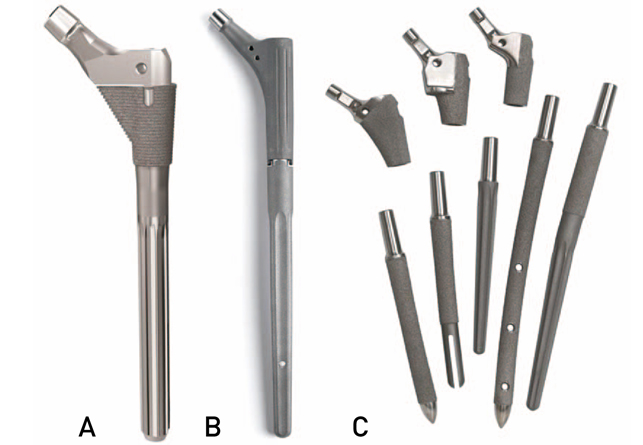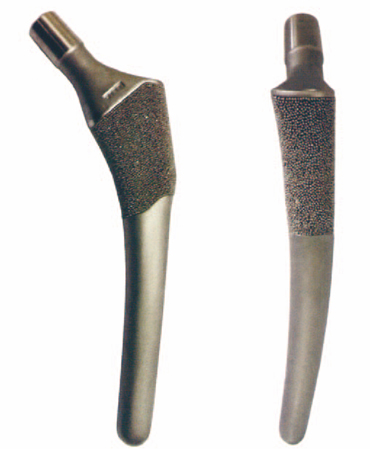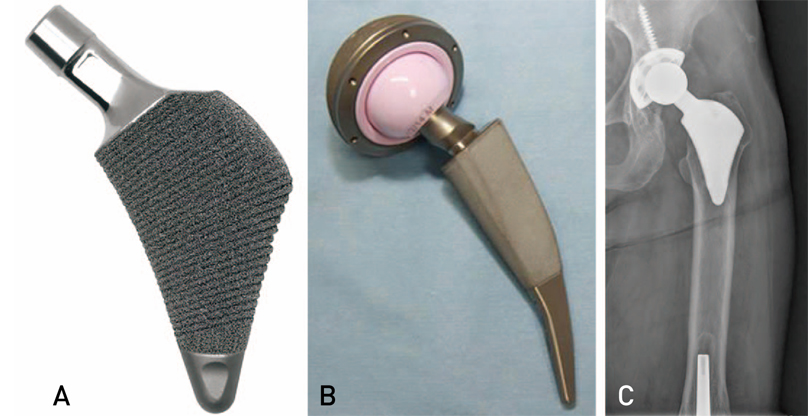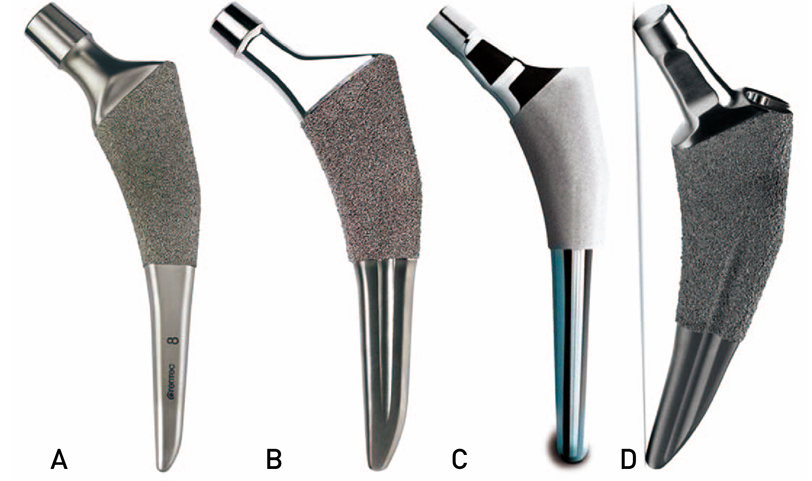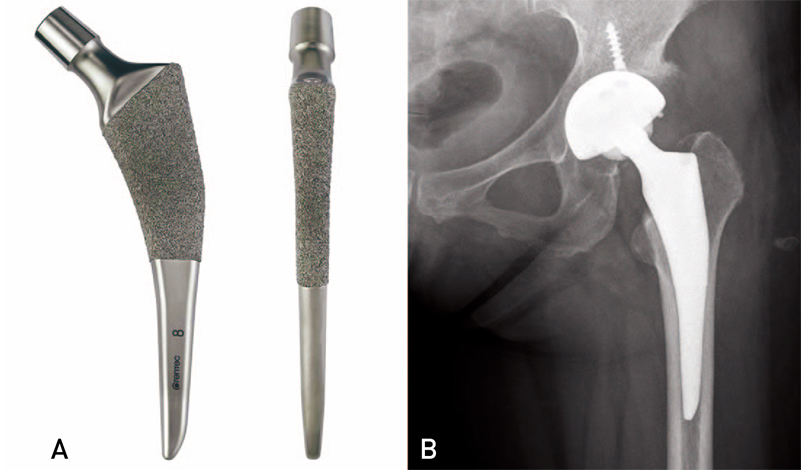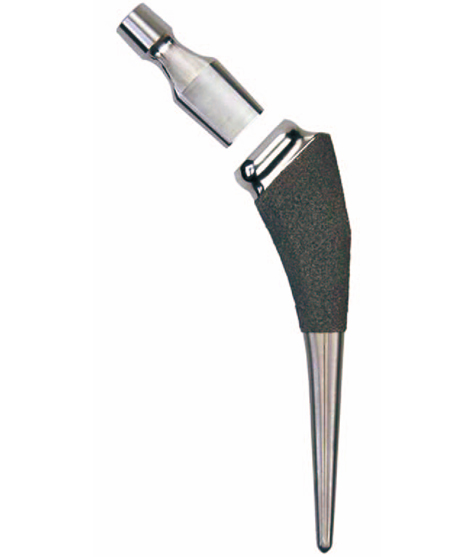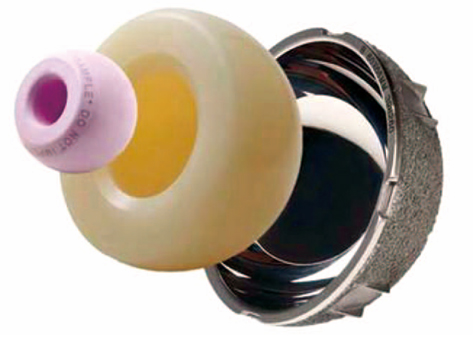Hip Pelvis.
2016 Jun;28(2):65-75. 10.5371/hp.2016.28.2.65.
Implant Design in Cementless Hip Arthroplasty
- Affiliations
-
- 1Department of Orthopaedic Surgery, Seoul National University College of Medicine, Seoul, Korea. jjyos@snu.ac.kr
- KMID: 2328341
- DOI: http://doi.org/10.5371/hp.2016.28.2.65
Abstract
- When performing cementless hip arthroplasty, it is critical to achieve firm primary mechanical stability followed by biological fixation. In order to achieve this, it is essential to fully understand characteristics of implant design. In this review, the authors review fixation principles for a variety of implants used for cementless hip replacement and considerations for making an optimal selection.
Figure
Cited by 2 articles
-
Clinical and Radiological Outcomes of Rectangular Tapered Cementless Stem According to Proximal Femoral Geometry in Elderly Asian Patients
Joon Soon Kang, Sang Hyun Ko, Yeop Na, Yung Hun Youn
Hip Pelvis. 2019;31(4):224-231. doi: 10.5371/hp.2019.31.4.224.Hip Arthroplasty Using the Bencox® Hip System: An Evaluation of a Consecutive Series of One Thousand Cases
Joong-Myung Lee, Young-Suk Sim, Dae-Sung Choi
Hip Pelvis. 2018;30(4):210-218. doi: 10.5371/hp.2018.30.4.210.
Reference
-
1. Khanuja HS, Vakil JJ, Goddard MS, Mont MA. Cementless femoral fixation in total hip arthroplasty. J Bone Joint Surg Am. 2011; 93:500–509.
Article2. Yamada H, Yoshihara Y, Henmi O, et al. Cementless total hip replacement: past, present, and future. J Orthop Sci. 2009; 14:228–241.
Article3. Friedman RJ, Black J, Galante JO, Jacobs JJ, Skinner HB. Current concepts in orthopaedic biomaterials and implant fixation. Instr Course Lect. 1994; 43:233–255.
Article4. Ries MD. Review of the evolution of the cementless acetabular cup. Orthopedics. 2008; 31.5. Callaghan JJ, Rosenberg AG, Rubash HE. The adult hip. 2nd ed. New York: Lippincott Williams & Wilkins;2007. p. 980–1052.6. Burt CF, Garvin KL, Otterberg ET, Jardon OM. A femoral component inserted without cement in total hip arthroplasty. A study of the Tri-Lock component with an average ten-year duration of follow-up. J Bone Joint Surg Am. 1998; 80:952–960.
Article7. McLaughlin JR, Lee KR. Total hip arthroplasty with an uncemented tapered femoral component. J Bone Joint Surg Am. 2008; 90:1290–1296.
Article8. Epinette JA, Manley MT. Uncemented stems in hip replacement--hydroxyapatite or plain porous: does it matter? Based on a prospective study of HA Omnifit stems at 15years minimum followup. Hip Int. 2008; 18:69–74.
Article9. Lee GY, Srivastava A, D'Lima DD, Pulido PA, Colwell CW Jr. Hydroxyapatite-coated femoral stem survivorship at 10 years. J Arthroplasty. 2005; 20:7 Suppl 3. 57–62.
Article10. Park MS, Choi BW, Kim SJ, Park JH. Plasma spray-coated Ti femoral component for cementless total hip arthroplasty. J Arthroplasty. 2003; 18:626–630.
Article11. Schuh A, Schraml A, Hohenberger G. Long-term results of the Wagner cone prosthesis. Int Orthop. 2009; 33:53–58.
Article12. Kolb A, Grübl A, Schneckener CD, et al. Cementless total hip arthroplasty with the rectangular titanium Zweymüller stem: a concise follow-up, at a minimum of twenty years, of previous reports. J Bone Joint Surg Am. 2012; 94:1681–1684.
Article13. Reigstad O, Siewers P, Røkkum M, Espehaug B. Excellent long-term survival of an uncemented press-fit stem and screw cup in young patients: follow-up of 75 hips for 15-18 years. Acta Orthop. 2008; 79:194–202.
Article14. Suckel A, Geiger F, Kinzl L, Wulker N, Garbrecht M. Long-term results for the uncemented Zweymuller/Alloclassic hip endoprosthesis. A 15-year minimum follow-up of 320 hip operations. J Arthroplasty. 2009; 24:846–853.
Article15. Zweymüller KA, Lintner FK, Semlitsch MF. Biologic fixation of a press-fit titanium hip joint endoprosthesis. Clin Orthop Relat Res. 1988; (235):195–206.16. Belmont PJ Jr, Powers CC, Beykirch SE, Hopper RH Jr, Engh CA Jr, Engh CA. Results of the anatomic medullary locking total hip arthroplasty at a minimum of twenty years. A concise follow-up of previous reports. J Bone Joint Surg Am. 2008; 90:1524–1530.
Article17. Hennessy DW, Callaghan JJ, Liu SS. Second-generation extensively porous-coated THA stems at minimum 10-year followup. Clin Orthop Relat Res. 2009; 467:2290–2296.
Article18. Biant LC, Bruce WJ, Assini JB, Walker PM, Walsh WR. The anatomically difficult primary total hip replacement: medium- to long-term results using a cementless odular stem. J Bone Joint Surg Br. 2008; 90:430–435.19. Cameron HU, Keppler L, McTighe T. The role of modularity in primary total hip arthroplasty. J Arthroplasty. 2006; 21:4 Suppl 1. 89–92.
Article20. Heekin RD, Callaghan JJ, Hopkinson WJ, Savory CG, Xenos JS. The porous-coated anatomic total hip prosthesis, inserted without cement. Results after five to seven years in a prospective study. J Bone Joint Surg Am. 1993; 75:77–91.
Article21. Kim YH. The results of a proximally-coated cementless femoral component in total hip replacement: a five- to 12-year follow-up. J Bone Joint Surg Br. 2008; 90:299–305.22. Kim YH, Kim JS, Cho SH. Primary total hip arthroplasty with a cementless porous-coated anatomic total hip prosthesis: 10- to 12-year results of prospective and consecutive series. J Arthroplasty. 1999; 14:538–548.
Article23. Feyen H, Shimmin AJ. Is the length of the femoral component important in primary total hip replacement? Bone Joint J. 2014; 96-B:442–448.
Article24. Falez F, Casella F, Papalia M. Current concepts, classification, and results in short stem hip arthroplasty. Orthopedics. 2015; 38:3 Suppl. S6–S13.
Article25. Kim YH, Park JW, Kim JS, Kang JS. Long-term results and bone remodeling after THA with a short, metaphyseal-fitting anatomic cementless stem. Clin Orthop Relat Res. 2014; 472:943–950.
Article26. Khanuja HS, Banerjee S, Jain D, Pivec R, Mont MA. Short bone-conserving stems in cementless hip arthroplasty. J Bone Joint Surg Am. 2014; 96:1742–1752.
Article27. Morrey BF, Adams RA, Kessler M. A conservative femoral replacement for total hip arthroplasty. A prospective study. J Bone Joint Surg Br. 2000; 82:952–958.28. Krishnan H, Krishnan SP, Blunn G, Skinner JA, Hart AJ. Modular neck femoral stems. Bone Joint J. 2013; 95-B:1011–1021.
Article29. Fitch DA, Ancarani C, Bordini B. Long-term survivorship and complication rate comparison of a cementless modular stem and cementless fixed neck stems for primary total hip replacement. Int Orthop. 2015; 39:1827–1832.
Article
- Full Text Links
- Actions
-
Cited
- CITED
-
- Close
- Share
- Similar articles
-
- Cementless Implant in Total Hip Arthroplasty
- Metal Debris Induced Osteolysis after Cementless Total Hip Arthroplasty: One case report
- Cementless bipolar hemiarthroplasty and cementless total hip replacement arthroplasty in avascular necrosis of the femoral head
- The History of Total Hip Arthroplasty
- Usefulness of a Modular Hip System for Combined Anteversion in Cementless Total Hip Arthroplasty

